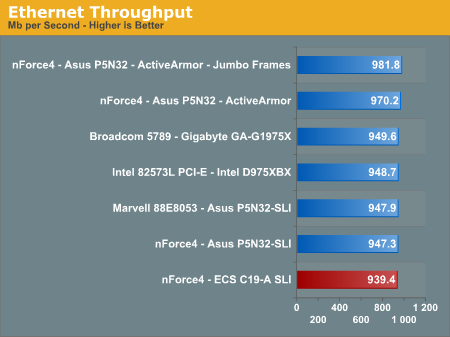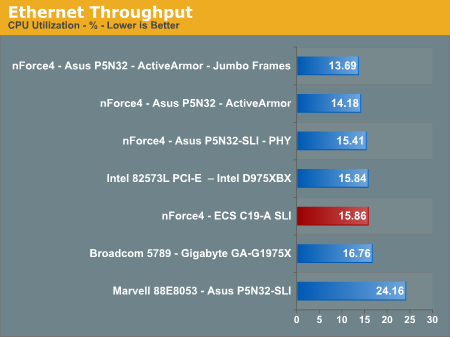NVIDIA nForce4 SLI XE: Enthusiast Features on a Budget
by Gary Key on March 23, 2006 12:05 AM EST- Posted in
- Motherboards
Ethernet Performance
The current motherboard test suite includes LAN performance measurements. All of these boards utilize PCI or PCI Express controllers with the only difference being the supplier of the core logic.
The Windows 2000 Driver Development Kit (DDK) includes a useful LAN testing utility called NTttcp. We use the NTttcp tool to test Ethernet throughput and the CPU utilization of the various Ethernet Controllers used on the motherboards.
We set up one machine as the server; in this test, an Intel system with an Intel CSA Gigabit LAN connection. Intel CSA has a reputation for providing fast and consistent throughput, so this seemed to be a reasonable choice to utilize for our testing.
At the server side, we used the following Command Line as suggested by the VIA whitepaper on LAN testing:
All standard Ethernet tests were performed with standard frames and the NVIDIA Active Armor suite disabled unless otherwise noted. Gigabit Ethernet supports Jumbo frames as well and provides a further reduction in CPU overhead. We included an additional test scenario in which ActiveArmor and Jumbo frames were enabled on the Asus P5N32-SLI Deluxe board via the 6.85 WHQL platform driver set. This is shown for illustrative purposes and demonstrates the favorable impact of this technology.
The current motherboard test suite includes LAN performance measurements. All of these boards utilize PCI or PCI Express controllers with the only difference being the supplier of the core logic.
The Windows 2000 Driver Development Kit (DDK) includes a useful LAN testing utility called NTttcp. We use the NTttcp tool to test Ethernet throughput and the CPU utilization of the various Ethernet Controllers used on the motherboards.
We set up one machine as the server; in this test, an Intel system with an Intel CSA Gigabit LAN connection. Intel CSA has a reputation for providing fast and consistent throughput, so this seemed to be a reasonable choice to utilize for our testing.
At the server side, we used the following Command Line as suggested by the VIA whitepaper on LAN testing:
Ntttcpr -m 4 ,0,‹server IP› -a 4 -l 256000 -n 30000On the client side (the motherboard under test), we used the following Command Line:
Ntttcps -m 4 ,0,‹client IP› -a 4 -l 256000 -n 30000At the conclusion of the test, we capture the throughput and CPU utilization figures from the client screen.


All standard Ethernet tests were performed with standard frames and the NVIDIA Active Armor suite disabled unless otherwise noted. Gigabit Ethernet supports Jumbo frames as well and provides a further reduction in CPU overhead. We included an additional test scenario in which ActiveArmor and Jumbo frames were enabled on the Asus P5N32-SLI Deluxe board via the 6.85 WHQL platform driver set. This is shown for illustrative purposes and demonstrates the favorable impact of this technology.










12 Comments
View All Comments
mindless1 - Saturday, March 25, 2006 - link
Well, you could just tell us. Previously ECS used a lot of OST caps but these may be Panasonic FM? (at least some, the 10mm x 25(?)mm look like it in the VRM. More significant might be the lack of capacitors for memory, could be part of why the board is a bit fickle about o'c.Per Hansson - Saturday, March 25, 2006 - link
Sounds very good Gary ;-)